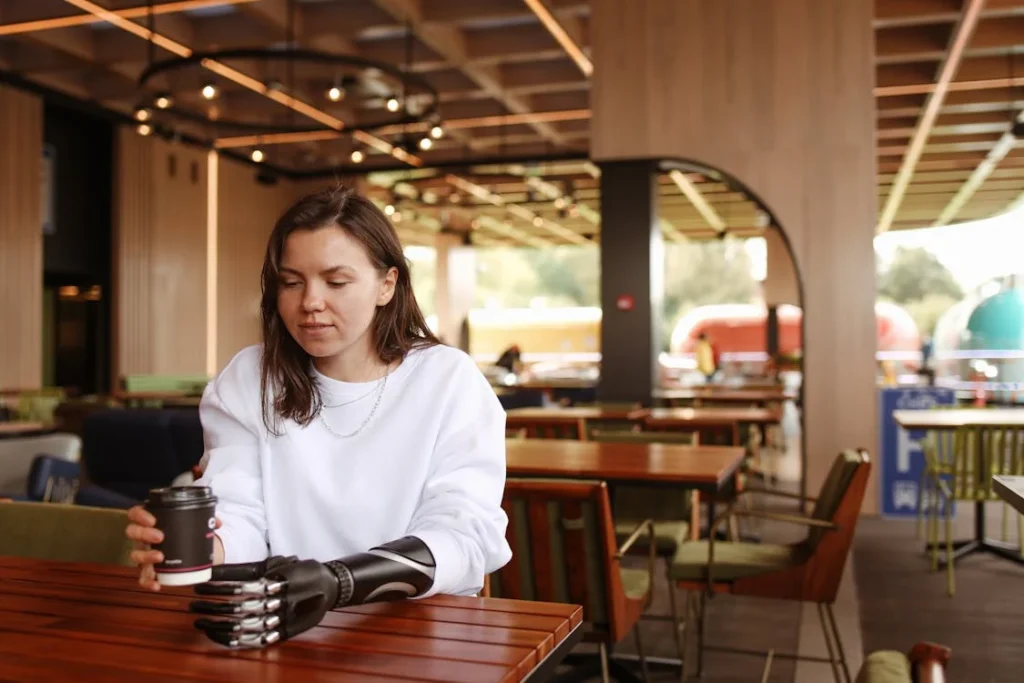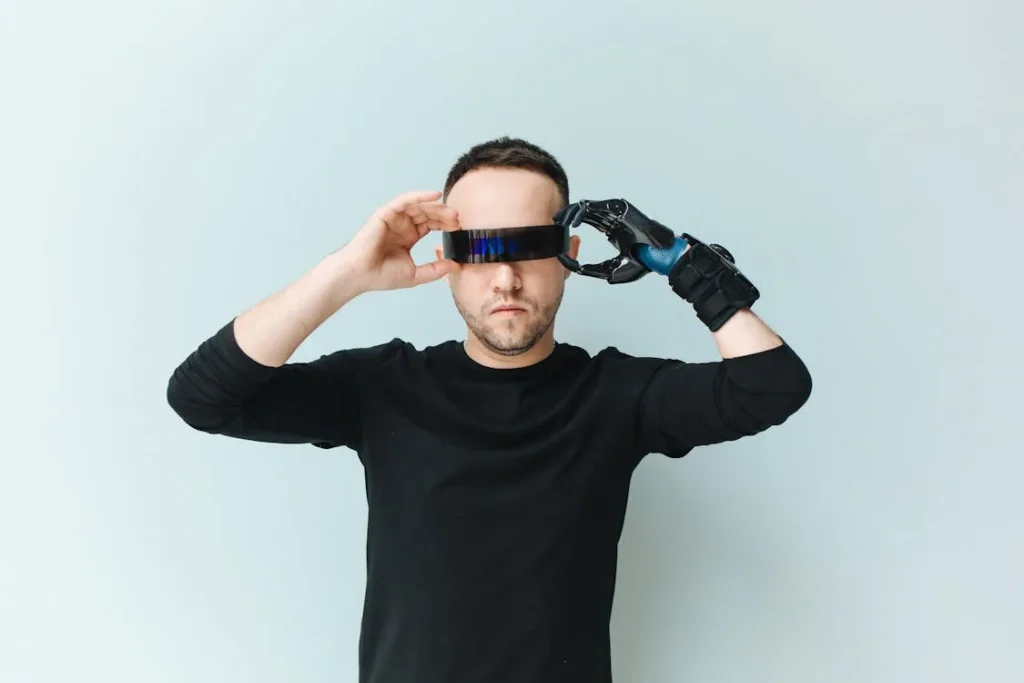We all use our hands without thinking. We gently lift a teacup. We carry heavy bags. We adjust our grip without noticing. It’s natural, effortless, and automatic. But if your hand is missing, this simple balance between soft and strong grip becomes a real challenge.
At RoboBionics, we’ve spent years studying how the human hand handles both fragile and heavy objects. And more importantly, we’ve built a bionic hand—Grippy™—that can do the same.

Why Grip Adjustment Is Not One-Size-Fits-All
Holding things might seem simple. But when you really think about it, your hand is doing something incredible. It can tell the difference between a soft bread roll and a steel water bottle. It knows how hard to squeeze so the bread doesn’t get crushed or the bottle doesn’t slip.
This fine control—changing grip strength depending on the object—is something we all do naturally. But for someone using a bionic hand, it has to be learned and built from scratch.
That’s where smart grip adjustment comes in. It’s the hidden intelligence inside Grippy™ that makes holding different objects feel easy, safe, and natural. But designing that feature wasn’t easy. It took understanding how people live their daily lives, what they hold, and how they move.
We noticed early on that many prosthetic hands in the market could grip tightly, but they couldn’t adjust. They would either hold too hard—risking damage to delicate items—or too loose, dropping heavier things. In both cases, users didn’t trust the hand. And when you don’t trust something, you stop using it.
So we asked: what does it really take for a hand to grip smartly? How do we teach a machine the difference between an egg and a brick? And how do we make that decision happen in a split second?
Understanding Pressure Through the Fingers
The first step to smart grip adjustment is knowing how much pressure the hand is applying. Just like your natural hand has nerves that send signals to your brain, Grippy™ has sensors in its fingertips.
These sensors measure force. They know if the fingers are pressing too hard, not enough, or just right.
But that’s only part of the story. Pressure sensing is useless if the hand can’t respond. That’s why we’ve given each finger its own motor. That means each finger can move and adjust independently.
If the index finger feels too much pressure, it can stop or ease up, while the thumb continues to support the grip. This kind of movement feels more like a real hand—and that’s what users notice right away.
These changes aren’t delayed. They happen in milliseconds. So when a user picks up a fragile glass, the fingers gently close until the pressure is just enough. If the glass shifts, the hand adjusts.
And if the user suddenly picks up something heavier, like a frying pan, the motors work together to add more grip where needed—without having to tell the hand what to do.
Responding to Muscle Signals in Real Time
Grippy™ uses myoelectric signals—that means it listens to your muscles. Even if someone has lost their hand, the muscles in their forearm still fire when they imagine gripping or relaxing. Grippy™ picks up those tiny electrical signals through skin sensors and translates them into movement.
But here’s where the smart part kicks in. We don’t just take one signal and make the hand move. We read the pattern of signals and match it with how the object feels.
If your muscles are relaxed and the object is light, Grippy™ knows not to squeeze too hard. If your muscles tighten and the object is heavier or slipping, the hand responds by gripping firmer.
This blend of muscle input and sensor feedback creates a natural loop. You move the hand, the hand responds, the object changes, the hand adapts—all without overthinking.
That’s the magic of smart grip adjustment. It gives control back to the user in a way that feels familiar, not forced.
Fragile Items Require More Than a Soft Touch
You might think gripping fragile items is just about using less force. But it’s more complicated. Fragile objects, like paper cups, fruits, or glassware, often change as you hold them.
They might bend, shift, or wobble. So the hand has to be both gentle and responsive. It can’t just grip softly and stay still—it has to listen to what the object is doing.
That’s why Grippy™’s sensors don’t stop after the grip begins. They keep checking. If the object starts to slip, the hand makes micro-adjustments.
These small changes in grip strength are too fast for the eye to see, but they make a big difference. They’re what stop a grape from being crushed or a pen from slipping.
This level of control brings huge confidence. People can pour tea, crack eggs, write with a pencil, or hold a baby’s bottle—all without fear. And it feels intuitive. Most users say it’s like getting a part of their body back, not learning to use a gadget.
Heavy Objects Demand Strength, But Also Stability
When it comes to holding heavy objects, the first thought that comes to mind is strength. And yes, strength matters. But in the world of bionic hands, strength alone is not enough.
It’s not just about gripping something tightly. It’s about keeping it stable, preventing it from slipping, and making sure the user doesn’t feel like they’re fighting the hand every step of the way.
At RoboBionics, we understood this early. Many prosthetic hands can technically lift weight—but that doesn’t mean they’re easy or safe to use when handling heavy items.
We saw people strain to carry simple objects like steel lunch boxes, grocery bags, or even tools, not because the hand couldn’t lift the weight, but because it couldn’t balance it properly or hold it securely during motion.
That’s why we focused on something deeper: smart strength. A grip that isn’t just firm, but also intelligent. One that holds steady without being rigid. One that supports the wrist and fingers evenly. One that adapts to how the object pulls or shifts as the user moves.
Challenge: Managing Grip Distribution for Larger Loads
Most people don’t realize how much a heavy object challenges the entire hand—not just the fingers. Your wrist, palm, and even forearm all play a role in stabilizing the item. In a bionic hand, every one of those points has to be designed to work together.
If the weight is unevenly distributed, the object tilts or slips. If the wrist can’t hold its angle, the object feels awkward. And if the grip doesn’t adjust when the item moves, the user ends up working harder than they should.
We solved this in Grippy™ by building smarter coordination between its fingers and wrist module. When the user picks up something heavy, the hand senses the pressure across all fingers and adjusts each one to carry part of the load.
Instead of a single point of tension, the grip spreads the force out—just like a natural hand does. This makes it easier to hold the object without tiring out or losing control.
The wrist, too, plays a key role. With the optional rotating module, users can change the angle of the grip to keep their wrist comfortable while still carrying the object steadily. That means fewer awkward movements, better posture, and less muscle fatigue over time.
Adapting to Shifting Weight During Motion
Heavy objects don’t just sit still in your hand. They pull. They shift. They swing slightly when you walk. Think about holding a bag of rice or a bucket of water.
The contents move, the weight shifts, and your hand must adjust constantly to keep balance. Your natural hand does this without thought. For a bionic hand, it’s a serious design challenge.
With Grippy™, we introduced active grip monitoring. As the object moves, the sensors continuously read how much pressure is needed. If the load shifts to the left, the hand adjusts the grip on the left fingers slightly tighter.
If the weight leans forward, the hand compensates by adjusting its posture. All of this happens in real time, within milliseconds.
This constant recalibration is what keeps heavy objects from tipping or dropping. It’s what lets a user carry their backpack or a shopping bag with confidence, knowing the hand won’t suddenly let go or struggle to adjust.
What’s more, the motors inside Grippy™ are built for endurance. They don’t overheat during longer tasks. They don’t lose power suddenly. And they’re efficient enough to handle repeated heavy grips without draining the battery quickly.
This makes the hand not just functional, but reliable—something users depend on daily.
Training the Grip for Specific Heavy Tasks
Everyone’s daily routine is different. Some people work in kitchens and lift pots. Others are mechanics handling tools. Some are students lifting books or backpacks. That’s why we didn’t stop at just one type of grip. We made Grippy™ programmable to learn from the user.
As the user performs repeated tasks, the hand remembers grip patterns. It starts recognizing the muscle signals associated with a heavy object and automatically adjusts the force needed. Over time, the grip becomes second nature—tailored to how the individual moves.
We also offer training through our gamified rehab app, where users can simulate lifting and balancing heavy virtual objects to build muscle memory. This isn’t just about strength—it’s about skill. And as that skill improves, the user feels more connected, more confident, and more in control.
What surprises many new users is how quickly they adapt. At first, there may be hesitation when lifting something heavy. But within a few days or weeks, we’ve seen users confidently carry groceries, lift pans, and even help with household chores. That’s not just a hand working—it’s a person getting their rhythm back.

How Grippy™ Balances Grip Power With Safety
When you grip something fragile, like a biscuit or a flower stem, you’re careful. But when you grab something heavy, like a full shopping bag or a cooking pot, you switch without thinking. Your hand just knows how much force to apply.
This balance between power and safety is what makes the human hand so special—and so difficult to recreate in a bionic design.
At RoboBionics, we didn’t just want to copy the hand’s shape. We wanted to copy its sense. That meant making sure Grippy™ doesn’t just hold objects tightly or softly—it holds them safely. That’s the difference between a basic mechanical grip and a smart, responsive one.
Protecting Fragile Items Without Guesswork
One of the biggest fears for new users is breaking something. Whether it’s cracking a cookie or dropping a phone, that first grip is filled with hesitation. We saw this again and again during our early trials. People were unsure how the hand would respond. Would it crush? Would it let go too soon?
To solve this, we built a safety-first pressure system inside Grippy™. This system learns from your movements. If the object is small and light, the sensors tell the fingers to ease up. But if there’s resistance—like when holding a soft fruit—the hand holds just tight enough to be secure, never squeezing more than needed.
This precision doesn’t require the user to think. It becomes part of their instinct. The hand adapts with each use. And because the fingers are independently controlled, the grip feels soft and even, not stiff or clumsy. This makes users feel safe again—like they’re in control, not guessing.
And once that confidence returns, so do the everyday moments that matter. Eating a biscuit without breaking it. Holding a glass without gripping too hard. Turning a page in a book without tearing it. These are more than tasks. They’re small victories of trust rebuilt.
Preventing Over-Gripping in Dynamic Conditions
Real life doesn’t happen in still frames. Your body moves. Objects shift. The hand has to respond without overcorrecting. Some prosthetic hands in the market tend to overcompensate. If something starts to slip, they grip too hard, which can damage the object or surprise the user. That’s not helpful. That’s stressful.
With Grippy™, we use a feedback loop that balances pressure with timing. If the sensors detect motion or slipping, they first try a micro-adjustment. Only if the object keeps moving does the hand slowly increase grip. This layered response makes the grip feel more natural. It stops the object, not the moment.
The result is smoother actions. Users can walk while holding fragile items. They can hold a wobbly plastic cup or a book with uneven weight and still feel confident. The hand supports, adapts, and follows—not reacts aggressively.
This is important, especially for users with jobs, families, or active routines. They don’t want to hold back. They want to do things their way, without thinking twice. And now, they can.
When Holding Heavy Things, It’s Not Just About Force
You might think that to lift something heavy, the hand just needs to grip tighter. But too much force can be dangerous. It can crack hard plastic handles or damage the object—or worse, hurt the user’s residual limb.
We designed Grippy™ with safety in mind. Its grip force is strong, yes—but it’s controlled. The motors are built to provide strength while still checking with the sensors at every stage. If the load increases, the hand strengthens its grip in balance with what the body can handle.
This keeps the action safe and steady. No sudden jerks. No overshooting. And no stress on the user’s arm.
We’ve also designed the inside of the socket—the part where the hand attaches to the user’s arm—to help absorb some of the shock from heavier loads. This makes carrying feel smoother and less tiring. The grip may be doing the work, but the entire design supports the person wearing it.
This holistic approach is what makes Grippy™ stand out. It’s not just about how the fingers close. It’s about how the entire hand moves with you—safely, quietly, and naturally.
Confidence Comes From Consistency
One thing we learned early is that people don’t just want power. They want predictability. The hand must perform the same way, every time. Because if the grip changes from one object to the next without warning, the user starts to second-guess. And that hesitation can make life harder, not easier.
So we made sure Grippy™ isn’t moody or inconsistent. Its sensors are calibrated to deliver the same smooth grip day after day. It doesn’t matter if it’s morning or night, cold or hot, busy or calm—the response stays reliable.
This consistency helps users build routines. They start using the hand without thinking. They trust it. And that trust brings a new kind of freedom—the freedom to just live.

Training the Mind and Muscles to Master the Grip
Smart grip adjustment doesn’t just come from technology—it also comes from people. Even the most advanced bionic hand won’t feel natural unless the person wearing it feels connected to it.
That connection isn’t built overnight. It comes from training, patience, and slowly rebuilding the bridge between the mind, the muscles, and the new hand.
At RoboBionics, we don’t just give users a device and wish them luck. We guide them through a complete learning journey. Because the real power of Grippy™ doesn’t lie in its motors or sensors—it lies in how easily it becomes part of you.
Starting With Muscle Memory
When someone loses a hand, the brain still remembers what that hand could do. The muscles that once controlled fingers still try to fire. This leftover activity is incredibly useful. It’s how Grippy™ understands what you want to do—by reading those small, electric signals from your muscles.
But at first, those signals can be weak or unclear. It’s like trying to speak a language you haven’t used in a long time. That’s where training comes in.
We help users rebuild strength in their residual limb using tools like our BrawnBand™—a light, wearable muscle stimulator. It gently activates muscle groups, helping them fire more clearly and consistently.
This step isn’t just physical. It’s mental. As users feel their muscles waking up, they begin to reconnect with the idea of movement. They stop seeing their arm as limited. They start seeing it as ready.
Once those signals become stronger, Grippy™ responds more precisely. The hand begins to feel like it’s listening—and for the first time in a long time, the user starts to feel heard.
Mastering the Feel of Different Objects
Grippy™ is built to adjust its grip depending on the object. But the user still plays a role. They decide when to pick something up, how to position their hand, and what kind of action they want—lifting, twisting, passing, holding. That’s why we train users with real objects, not just theory.
In our demo sessions, we ask users to try all kinds of items: water bottles, soft fruits, steel plates, delicate plastic, paper cups. We help them feel the difference.
We show them how a small shift in muscle tension changes how Grippy™ grips. The hand does the work—but the user tells it how.
At first, some people feel unsure. They hold everything too softly, or over-grip out of fear. But within a few days, something changes. They start to relax. They stop overthinking. The grip becomes second nature.
This process is more than just muscle training—it’s confidence training. When users see that they can hold a flower and not crush it, or lift a full bag and not drop it, their trust in themselves grows.
That trust spreads. Soon they’re doing more—writing, cooking, feeding themselves, maybe even sketching or fixing tools. And it all starts with mastering that simple motion: the grip.
Using Technology to Build Habits
To support learning outside of training centers, we created a gamified app that helps users practice gripping, adjusting, and reacting to virtual objects. It’s fun, colorful, and surprisingly powerful.
Users play mini-games where they pick up falling items, squeeze targets just right, or sort virtual objects by weight. Behind the scenes, the app is reading their movements and helping fine-tune muscle control.
This isn’t just for fun—it’s neuroscience. The more often your brain practices a skill, the stronger those neural pathways become. Every game played helps reinforce how the hand should move, how it should feel, and how the brain and muscles should work together.
We’ve seen users who started off shy and unsure become masters of their new hand—just by spending a little time each day with the app. It turns learning into a habit. And that habit becomes freedom.
Celebrating Milestones, Big and Small
We believe progress should be celebrated. That’s why we mark every win—no matter how small. First time picking up a pen? That’s a big deal. First time pouring water into a glass without spilling? Incredible.
These wins matter. They show users that they’re not just getting used to the hand—they’re owning it.
We encourage families to celebrate with them. We ask trainers to recognize progress. Because when someone feels supported, they keep going. And when they keep going, the grip becomes stronger, smoother, and more a part of everyday life.
Some users tell us, “I forgot it was a bionic hand today.” That’s the best feedback we can get. It means they’ve moved past awareness. They’re not using a device. They’re just living.

Grip Surface Design: The Unsung Hero Behind Smart Holding
Most people, when they think of a bionic hand, focus on how the fingers move. They picture the mechanics, the motors, the high-tech sensors. But there’s one part that rarely gets the spotlight—even though it makes all the difference when it comes to actually holding things.
It’s the surface of the fingers.
The texture, material, and shape of the parts that touch the object matter just as much as how the hand moves. Whether the object is a soft sponge or a heavy metal pot, the surface design is what helps keep the item steady, safe, and secure.
At RoboBionics, we’ve spent just as much time perfecting the feel of Grippy™’s fingers as we have designing its brains and muscles.
Because grip isn’t just about strength. It’s about contact.
Why Finger Shape Affects Grip Confidence
When your natural hand grabs something, it wraps around the object’s shape. Your fingers curve slightly. Your thumb moves in just the right position. Even the pads of your fingers flatten a bit, creating a better hold.
We wanted Grippy™ to feel just as responsive. That’s why we designed each finger with a curved profile that mimics how a human finger bends. This allows the hand to cradle both round and flat objects easily. Whether it’s a cricket ball or a smartphone, the grip feels snug, not awkward.
The fingertips aren’t flat or rigid. They’re softly contoured. That might sound like a small design choice, but it makes a huge difference. It lets the fingers find natural contact points on any surface.
And more contact points mean more control—especially when the user is dealing with objects that are smooth or slippery.
This contour design also helps with grip on oddly shaped or uneven items—like vegetables, keys, or uneven jars. The fingers wrap around more like a real hand, increasing both holding power and user confidence.
The Role of Grip Texture in Holding Power
Smooth fingers slide. Grippy™ doesn’t.
The surface of the fingers has a special textured layer that adds just the right amount of friction. This is what stops a plastic cup from slipping. What helps a pen stay put while writing. What makes holding a phone or utensil feel secure, even with minimal pressure.
We tested dozens of materials before choosing the final one. It needed to be soft enough to handle fragile items without scratching them, yet strong enough to support heavier objects. It also had to stay effective even when wet, dusty, or oily—because life isn’t always clean.
The final result is a material that’s slightly rubbery to the touch, gentle on skin, and tough under pressure. It doesn’t wear down easily, and it doesn’t absorb sweat or grime. It just does its job—holding tight when the user needs it, and letting go cleanly when they don’t.
This grip texture also works hand-in-hand with Grippy™’s sensors. When the object begins to shift, the sensors detect it faster because there’s more surface feedback. That allows the hand to react before the object falls or moves too much—especially useful when walking or multitasking.
Finger Pad Pressure Zones: Small Details, Big Difference
Another breakthrough we made was designing the fingers with different “zones” of grip pressure. Not every part of your natural finger applies the same pressure. The tip, the middle pad, and the side of your finger each play a role. We recreated this in Grippy™ by shaping the pads of the fingers with slightly varied pressure zones.
The result? More control with less force. The fingertips focus on precision. The midsection holds firm. The side padding offers stability. This structure allows the hand to do more with each grip—whether it’s a light touch on a wafer biscuit or a steady hold on a steel plate.
This design is also great for people who like to multi-grip—holding objects in more than one position. A user can shift from a palm grip to a pinch grip without losing control. The hand moves with them, not against them.
This flexibility is crucial in everyday use. From opening a snack packet to grabbing a handlebar, the surface matters more than most people realize. It’s not about fancy features. It’s about making the hand feel human.

Growing With the Grip: Designing Smart Hands for Children and Teens
When we think about bionic hands, we often picture adults—someone working, commuting, cooking, or managing a household. But what about a 10-year-old who wants to tie their shoelaces? Or a 14-year-old who dreams of riding a bicycle again? For children and teenagers, using a bionic hand like Grippy™ isn’t just about function—it’s about fitting in, feeling capable, and growing with confidence.
At RoboBionics, we’ve learned that designing for kids isn’t as simple as making a smaller version of an adult hand. Young users need different things. Their hands are still growing.
Their muscles are still developing. And their emotions around using a prosthetic are deeply personal. That’s why we’ve taken special care to make Grippy™ not just wearable, but welcoming—for even the youngest users.
Challenge: Small Hands, Big Potential
Children have smaller arms and less muscle strength. Their myoelectric signals are weaker and often more erratic. That makes reading and interpreting those signals a challenge. If the hand doesn’t respond well, the child may get frustrated quickly and stop using it altogether.
So we engineered Grippy™ to pick up even the faintest signals. We fine-tuned the sensitivity of our muscle sensors so that children can control the hand without straining. We also adjusted motor speed and grip force so that the hand feels gentler during use—but still strong enough to perform.
More than anything, we designed it to feel safe. Parents often worry about whether the hand will pinch, jam, or move unpredictably. We added safety checks, smoother closing speeds, and gentle vibration feedback so both kids and adults feel comfortable right from day one.
And because children’s limbs grow quickly, we offer size-adjustable sockets and easy refits. That way, the hand grows with the child—and doesn’t become something they outgrow emotionally or physically.
Learning Through Play and Exploration
For children, play is everything. It’s how they learn, how they express themselves, and how they build coordination. So we focused on making the learning process fun, not clinical.
Instead of formal grip drills, we encourage activities like stacking blocks, coloring with crayons, opening snack packets, or even learning to play simple instruments.
Grippy™ responds with the same smart grip adjustment we use for adults, but with kid-friendly feedback. Children can feel when they’re gripping too tightly or too softly through gentle vibrations or sounds. This helps them understand the concept of pressure without needing technical explanations.
We also noticed that kids love to test boundaries. They’ll throw the hand, bump it, splash water near it. That’s why we made our systems extra durable and sealed key areas to resist light dust and spills. We want the hand to support adventure, not stop it.
For teens, we see a different pattern. They want independence. They want style. They want to feel normal. So we made sure Grippy™ looks modern, clean, and even cool. With color customization, subtle design curves, and discreet controls, the hand doesn’t look like a medical device—it looks like theirs.
Supporting Self-Esteem and Belonging
Perhaps the most important part of designing for children and teens is understanding the emotional side. Growing up with limb difference can be lonely. Kids want to be like their friends. They don’t want stares or sympathy. They want to join in—on the playground, in the classroom, at home.
That’s why we take time to introduce the hand gently. We let the child explore it, ask questions, even decorate it if they want. We encourage schools to welcome the hand as a cool tech tool—not a symbol of disability. And we coach parents on how to support their child’s use of the hand without making it feel like a spotlight.
We’ve seen kids who were shy become the stars of their classroom robotics club. We’ve seen teens who avoided eye contact now make videos showing off their new skills. That shift doesn’t happen because of motors or sensors. It happens because of belief—ours in them, and theirs in themselves.
Conclusion
A hand does more than hold—it expresses, creates, connects. At RoboBionics, we’ve poured years of care, engineering, and empathy into designing a bionic hand that understands the difference between holding something fragile and lifting something heavy. But more importantly, we’ve built Grippy™ to understand people—their lives, their routines, their fears, and their hopes.
Smart grip adjustment isn’t just about force or technology. It’s about trust. It’s about knowing the hand will respond not just when needed, but how it’s needed. It’s about holding a glass without breaking it, a tool without dropping it, and a moment without missing it. Whether the user is a child, a parent, a worker, or an artist, we design for real life—one precise, gentle, and strong grip at a time.
Because at the heart of every smart hand, there’s a simple goal: to help people feel like themselves again. Confident. Capable. Independent. And ready to take on the world, one hold at a time.



